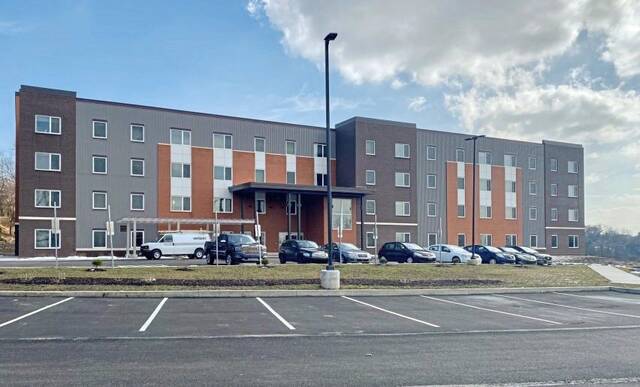New sustainable senior housing development opens in Penn Hills
Penn Hills seniors have a new residence option with the opening of Emerald Hills Retirement Village at the site of the former Forbes Elementary School.
It was built by Sota Construction, and was built to Passive House, Energy Star, and Enterprise Green building standards. Sota is dedicated to sustainable building.
“Sustainable building is building our future, and it is no easy task,” said Sota vice president Phil Ford. “We are facing many challenges today, including increasing demands for better air quality, rising energy costs and material and labor shortages.”
Emerald Hills Retirement Village is a 65,000 square foot, four-story building containing 52 one-and-two bedroom units. The building also includes a private parking lot, community room, exercise and recreation rooms and a library.
Unit prices are based on income. According to the Emerald Hills business manager, the most expensive option is a two-bedroom for $1,050 per month. The least expensive is a one-bedroom for $315 per month. Applications are currently being accepted for residence.
It features a solar array system that provides supplemental power to the building.
Passive housing focuses on the exterior envelope of a structure — it controls the airflow into the building and maintains filtration and ventilation without the use of active energy, according to Ford.
“In addition to the air quality, one of the great benefits in a passive house building is the thermal envelope,” Ford said. “If you imagine a regular building, with how it’s designed and constructed, basically, the slimmed down idea of passive housing is taking a big winter parka coat and putting it on the outside of the building.”
The thermal envelope is meant to keep the heat inside the building. It also collects solar gains — an increase in temperature in a structure caused by exposure to the sun’s heat — to gather new heat.
In the warmer months, a passive house will rely on passive and active shade to keep the heat at bay. For most climates, a heat or energy recovery ventilator will provide a constant supply of tempered, filtered fresh air. Using this system is meant to save space conditioning costs by recycling indoor energy , but also provides premium indoor air quality and consistent comfort. The system exchanges the air entirely, never re-circulating stale air inside the building.
According to deed transfers, Emerald Hills Retirement Village purchased the property from Penn Hills School District in September 2020 for $460,476.
Sota’s team quickly realized that they would need to demolish the elementary school due to structural and cost complications, and start from the ground up.
“Initially, we looked at the original Forbes Elementary School and said ‘hey let’s do what we’ve done before,’ because we’ve renovated a number of school projects,” Ford said. “After we looked at it, we decided to demolish it. It’s not our favorite thing to tear down buildings, because we believe the greenest building is the one that’s already constructed.”
In addition to the unexpected demolition, the project was also impacted by the coronavirus pandemic, which slowed down the funding and materials that the company needed.
After the building was demolished, the project took about 15 months and was completed in December of 2021. Sota Construction then brought in a professional to test the air tightness within the building. Certified Passive Houses normally have to meet the benchmark of 0.060 cubic feet per minute (CFM50). Emerald Hills passed with a measurement of 0.017 CFM50 per square foot of building envelope, according to Ford. This means that the building is only leaking 28% of the maximum allowable leakage, making it the best score the company has received on an air tightness test.
Haley Daugherty is a TribLive reporter covering local politics, feature stories and Allegheny County news. A native of Pittsburgh, she lived in Alabama for six years. She joined the Trib in 2022 after graduating from Chatham University. She can be reached at hdaugherty@triblive.com.
Remove the ads from your TribLIVE reading experience but still support the journalists who create the content with TribLIVE Ad-Free.


